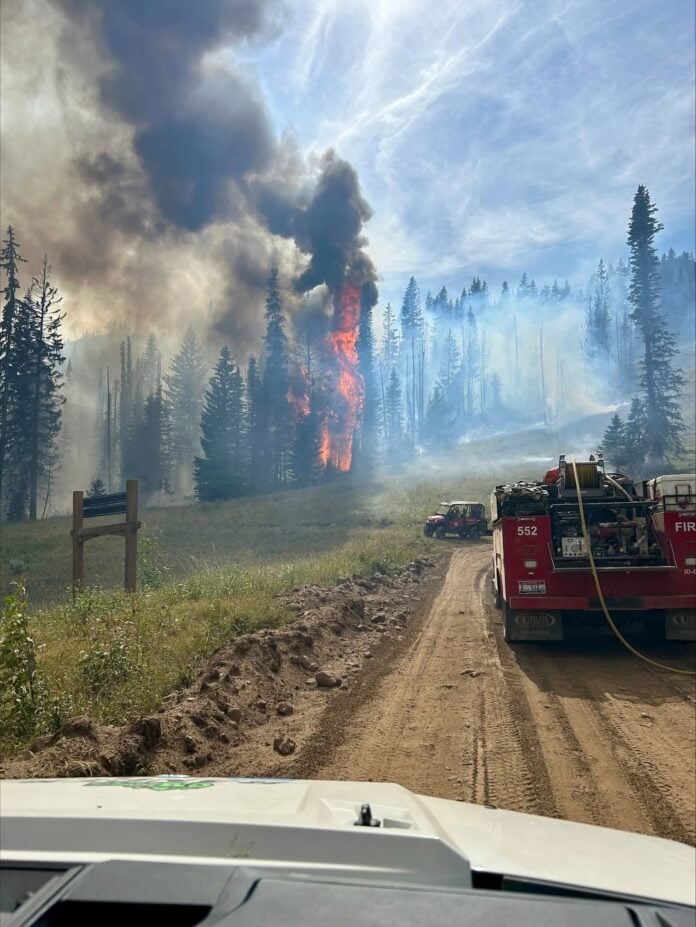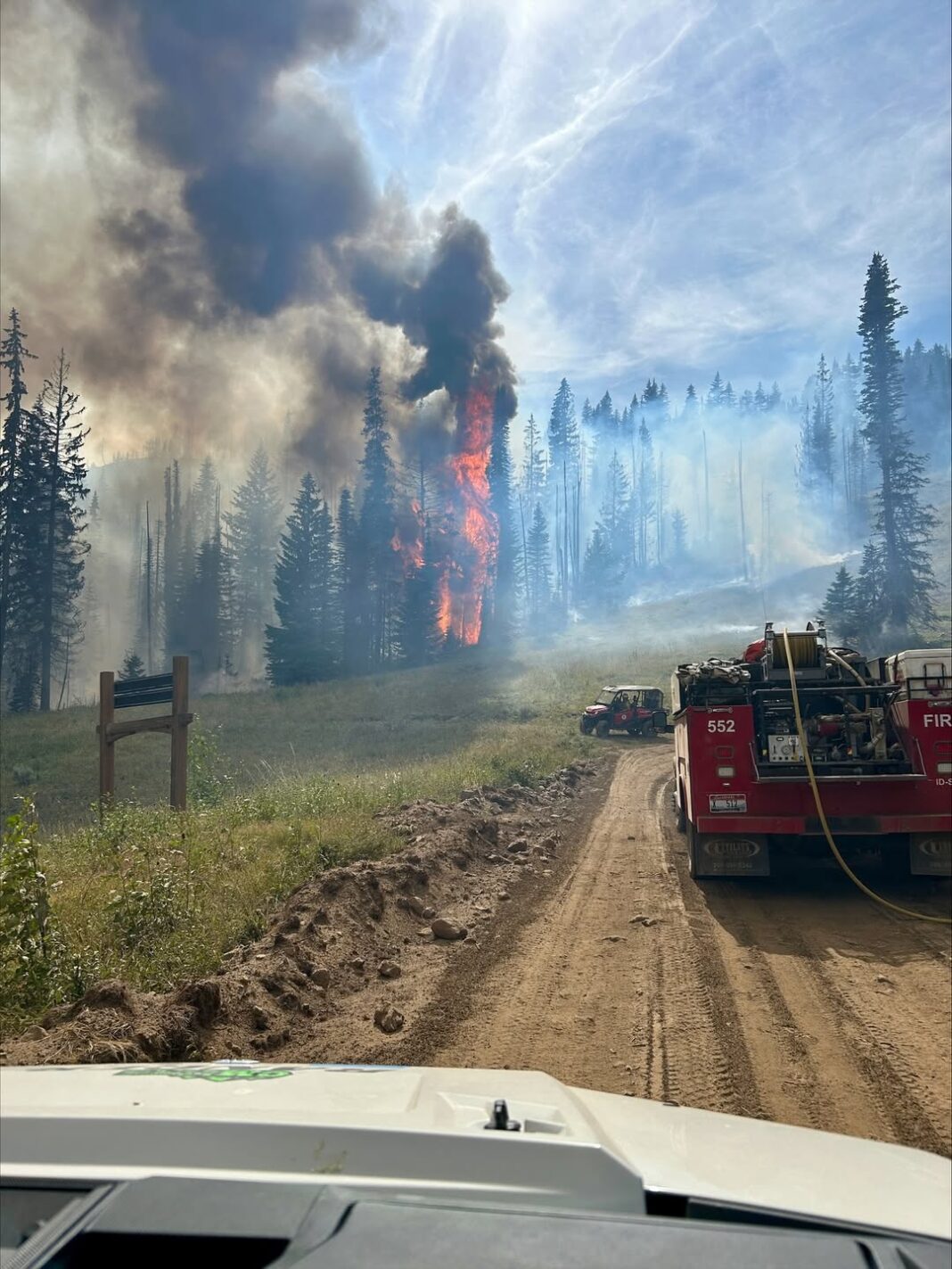Extensive defense lines built around a wildfire burning near Tamarack Resort will be put to the test this weekend by hot and dry conditions, according to incident managers.
The lightning-caused Rock Fire started on Aug. 12 about 1.5 miles south of the resort and has since burned 2,813 acres as of Friday morning, including up to the ski area’s southern boundary. Structures remain threatened, but none have been lost as of Friday.
The wildfire grew to about 1,900 acres within the first 24 hours of ignition amid hot, dry, and windy conditions, compared to about 900 acres burned over the last nine days.
The fire’s limited growth has enabled hand crews and dozers to establish containment lines around over 95% of the fire’s 33-mile perimeter, Operations Planning Chief Randy Lamb said during a community meeting in Donnelly on Thursday night.
Still, official containment of the Rock Fire remained at 0% as of Friday, which Lamb attributed to the fire burning in subalpine fir tree stands that can cast embers beyond containment lines.
“We can get lines around it, but then there’s a chance of those trees torching out,” he said. “There’s still a lot of work to do even when we have line around the fire.”
Crews are currently using hose lines to advance as far as 300 feet into the fire zone to mop up flames. Containment is expected to increase once that work is complete, according to the Boise National Forest.
‘More extreme’ fire conditions expected
Spencer Tangen of the National Weather Service’s Boise office, who is serving as the incident meteorologist, warned that the agency’s fire index will rise to the “more extreme” category on Friday and Saturday before moisture and cooler temperatures arrive next week.
Tangen expects winds to be lighter than normal, blowing from the west, northwest during the day and the east, northeast at night. Fire managers say the conditions will test containment lines built over the last nine days.
“The next couple days are going to be the tell-tale, if all this hard work we’ve been doing pays off,” said Valley County Emergency Manager Juan Bonilla, who is also the Donnelly Fire Chief. “I feel confident that we’ve done everything we could to this point.”
The Rock Fire has been under a full suppression strategy since it started Aug. 12. On Friday, 884 personnel, six helicopters, 33 engines, 17 pieces of heavy equipment, and 23 hand crews were working the fire.
A fleet of helicopters and airplanes has dumped nearly one million gallons of water and retardant on the fire.
Without donors like you, this story would not exist.
Make a donation of any size here
Northwestern line a priority
Crews are working both sides of the fire, but in recent days have been especially focused on the northwestern corner of the fire, which is burning southwest of Tamarack Resort.
Holding lines at that corner is a priority for fire managers because it would prevent the fire from outflanking fortified containment lines protecting structures in Tamarack and along West Mountain Road.
“We have 100 people crammed into a 75-acre spot back there because it’s very strategically important that we hold onto that corner,” Lamb said.

The lines have mostly held so far, but nightly winds from the east have driven the fire into subalpine fire stands that can ignite spot fires beyond established containment lines.
“The fire is moving from the ground into the tree canopies, and then you add the winds into it, and this is provided spotting opportunity from a 10th of a mile up to an actual mile (away),” said Jhennifer Williams, a fire behavior analyst with the Payette National Forest.
Crews were using heavy equipment on Friday to build a contingency containment line behind the main line in case it cannot be held.
However, firefighters have been assisted by grasses and sagebrush that, so far, are not burning. But that could change as conditions dry out this weekend.
“We are continuing to prepare for any change in any fire behavior,” Williams said.
Eastern flank slow burn
Meanwhile, Williams said the fire’s eastern flank, or the part closest to homes in Tamarack and along West Mountain Road, is burning at a lower intensity than other parts of the fire.
“The vegetation is a lot wetter on this side of the hill, it is sheltered from the winds, and the fire has to fight to move downhill,” she said. “So the intensity has been moderated quite a bit due to those reasons.”
Crews have established dozer lines between the eastern edge of the fire and homes, while also staging hose lines and water equipment for use if the fire draws near. Sprinkler systems were also set up to saturate the brush near homes.
Tamarack moved to “Set” evacuation stage

Still, Valley County moved evacuation orders from “Ready” to “Set” this week for West Mountain Zone 7, which contains Tamarack and other homes along West Mountain Road.
That decision, Sheriff Kevin Copperi said, is based on the proximity of the fire to structures.
“We make those lines in the ground and say, ‘if it passes here, we’re going to go to Set, or we’re going to go to Go,’” Copperi said at Thursday’s community meeting. “That’s how those are come up with.”
Currently, the county has alerts for three evacuation zones along West Mountain Road. West Mountain zones 5 and 6 are under the “Ready” stage, which means to monitor wildfire alerts and plan your evacuation. The “Set” stage calls for being ready to evacuate “at a moment’s notice.”
Copperi hinted that designations could be lowered or removed next week, but said that they would not be re-evaluated until after this weekend’s hot and dry spell passes.
“Our hard part is going to be the next couple of days, but the work they’ve done has been pretty remarkable,” he said.
Winds, old burn assisting
The Rock Fire has seen minimal growth to the south, with the southwestern boundary remaining near where lightning ignited the fire. That is in part due to winds mostly pushing the fire north, but also because of the scare from the 1,300-acre Hurd Fire in 2010.
“The fire actually has pretty much come to a halt there due to that fire scar and not having the available fuel to burn through,” Williams said. “So that’s been incredibly helpful for the crews.”
On the fire’s western flank, westerly winds have assisted firefighters in holding containment lines, pushing flames back toward the interior of the fire.

Post-fire work still to come
After the fire is declared out, the Boise National Forest will oversee work to restore areas where containment lines were dug, Agency Administrator David Francomb said.
The forest will also complete post-fire assessment work, including planting new seedlings and replacing culverts.
“We’re not done when the fire’s out,” Francomb said.
Fire managers sympathize with ‘smoke fatigue’
Throughout Thursday’s community meeting, fire managers repeatedly acknowledged and sympathized with the range of emotions in the room—frustration, confusion, gratitude, fear, and sadness among them.
“We recognize how hard it is for this community to face another season of fire,” said Incident Commander Jeremy Kiesling of Great Basin Team 6. “I know folks have fire fatigue. They have smoke fatigue. I’m from Reno, Nevada—I have smoke fatigue.”
Bonilla, Donnelly’s fire chief since 2007, offered an emotional statement near the end of Thursday’s meeting.
“This is my home, just like it is yours. I’ve lived here my whole life. My kids are fifth-generation,” he said. “So, we don’t like seeing our trees burn. We don’t like seeing people’s homes in trouble. All those homes are like our homes, especially here at Donnelly and all the fire districts. So, we care.”







